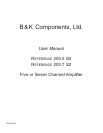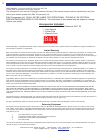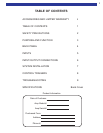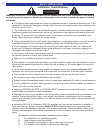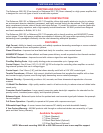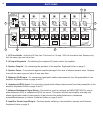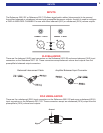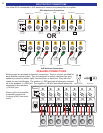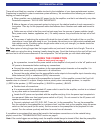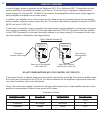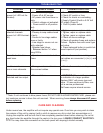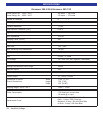
TROUBLESHOOTING
***Note: If unit continues to blow power fuses, DO NOT USE A HIGHER RATED FUSE, please con-
tact customer service to have the unit serviced. When servicing fuses always disconnect AC power
before replacing.
CARE AND CLEANING
Under normal use, the amplifier will not require any special care. Over time you may wish to clean
the exterior of the unit by wiping it with a cloth to remove any dirt or dust that accumulates on it.
Unplug the amplifier and be sure that it has completely powered down before cleaning. Do not let
any liquid enter the amplifier through the vents in the top cover. LIQUIDS CONDUCT ELECTRICI-
TY!!! You may clean the connectors on the back panel with isopropyl alcohol annually.
9
PROBLEM POSSIBLE CAUSE POSSIBLE SOLUTION
No sound
(power 'on' LED not illu-
minated).
1. Power cord not plugged in.
2. Power off at AC source.
3. AC power inlet fuse blown or
faulty.
4. Control voltage not activated.
5. Power switch in off position
(out).
1. Reconnect power cord.
2. Check AC switch or fuse.
3. Check for shorts or overloading.
4. Supply Control IN with a 5-24 Volt
DC supply (Page 8).
5. Push in power switch.
No sound on some or all
selected channels
(power 'on' LED illuminat-
ed).
1. Speaker leads loose or faulty.
2. Preamp to amp cables loose
or faulty.
3. Source to line stage cables
loose or faulty.
4. Line stage or source not cor-
rectly selected.
5. Speaker fuse blown.
6. Balanced button “in” when
using RCA’s.
1. Tighten, repair or replace cable.
2. Tighten, repair or replace cable.
3. Tighten, repair or replace cable.
4. Check all source settings.
5. Check all speaker fuses and replace
if blown. Replace fuse with same type
and value.
6. Press balanced button to switch bal-
anced inputs off (out position).
Sound lacks direction
weak bass.
1. Speakers connected out of
phase.
1. Check all connections making sure
that cables are connected (+) to (+) and
(-) to (-).
Loud hum or buzz on
one or more channels.
1. Poor ground connection in
inter-connect cables.
1. Check all connectors and repair as
necessary.
Channel sounds
distorted and low output.
1. Blown rail fuse. 1. WARNING: Blown rail fuses can be
an indication of a larger problem.
Replace ONLY with same type and
value. If fuses continue to blow, con-
sult a service professional.
Rail fuses require internal service.



